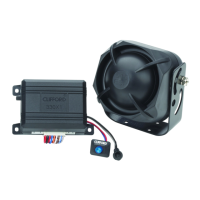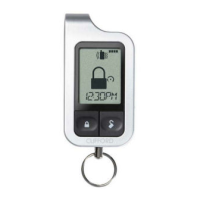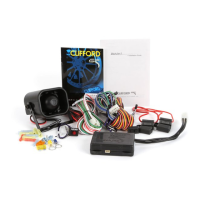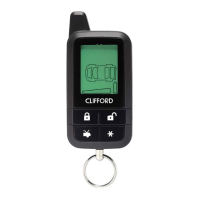Do you have a question about the Clifford RSX3.5 and is the answer not in the manual?
Steps and precautions before starting the installation process.
Tasks and checks to perform after the installation is complete.
Identifying and connecting to a reliable source of constant 12V power.
Method for locating the vehicle's ignition wire using a multimeter.
Procedure for identifying the starter wire with a multimeter.
Locating the vehicle's accessory wire for powering related systems.
Steps to find the tachometer wire using AC voltage measurement.
Methods for locating the positive (+) parking light wire.
Best locations and testing methods for the door pin switch trigger wire.
Pinout and function description for the 12-pin primary harness (H1).
Pinout and function description for the 6-pin auxiliary harness (H2).
Pinout and function for the 5-pin remote start harness (H3).
Connecting the PURPLE wire to the vehicle's starter wire.
Connecting the GREEN wire for anti-grind or starter kill function.
Connecting RED wires for high current 12V input to the relay satellite.
Connecting the ORANGE wire to the vehicle's accessory circuit.
Connecting the PINK wire to the vehicle's ignition wire.
Connecting the PINK/WHITE wire for a second ignition circuit.
Connecting the RED/WHITE wire for high current 12V input.
Connecting H3/1 BLACK/WHITE to the neutral safety switch for safe operation.
Connecting H3/2 VIOLET/WHITE for engine RPM information.
Connecting H3/3 BROWN to the brake light wire for safety shutdown.
Connecting H3/4 GRAY to the hood pinswitch for shutdown and zone triggering.
Procedure to test the neutral safety switch functionality.
Diagram showing how to bypass GM VATS systems using resistors and relays.
Information on GM Passlock I/II systems and bypass module requirements.
Overview of Passkey III and other transponder systems requiring bypass.
Step-by-step guide to program transmitters to the system.
Table mapping channel numbers to functions and wire colors.
Steps to access and initiate the system features programming.
Details on programming features and exiting the learn routine.
Verifies the brake pedal shutdown functionality.
Verifies the hood pin shutdown functionality.
Verifies the neutral safety switch shutdown functionality.
Detailed steps to test the neutral safety shutdown circuit.
Common alarm issues like sensor not triggering or door input delays.
Addresses issues with remote start activation or starter engagement.
Troubleshooting steps when the starter does not disengage after engine start.
Diagnosing why the vehicle only runs for a short duration.












